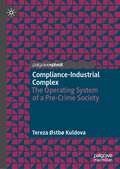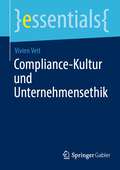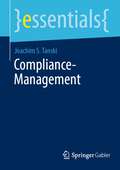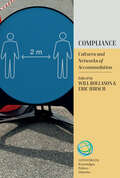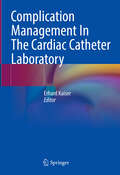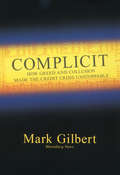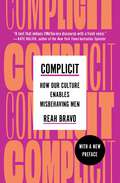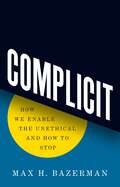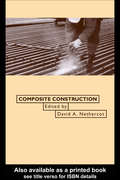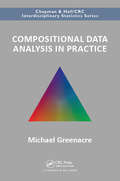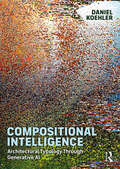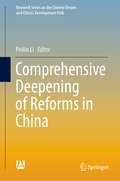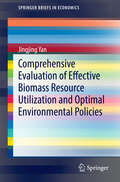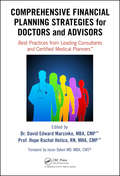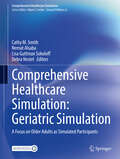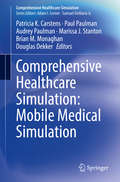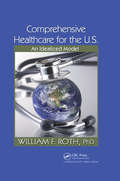- Table View
- List View
Compliance-Industrial Complex: The Operating System of a Pre-Crime Society
by Tereza Østbø KuldovaThis is the first book to examine the growth and phenomenon of a securitized and criminalized compliance society which relies increasingly on intelligence-led and predictive technologies to control future risks, crimes, and security threats. It articulates the emergence of a ‘compliance-industrial complex’ that synthesizes regulatory capitalism and surveillance capitalism to impose new regimes of power and control, as well as new forms of subjectivity subservient to the ‘operating system’ of a pre-crime society. Looking at compliance beyond frameworks of business management, corporate governance, law, and accounting, it looks as it as a social phenomenon, instrumental in the pluralization and privatization of policing, where the private intelligence, private security, and big tech companies are being concentrated at the very core of compliance, and hence, governance of the social. The critical book draws on transversal, rather than interdisciplinary, approaches and integrates disparate perspectives, inspired by works in critical criminology, critical algorithm studies, critical management studies, as well as social anthropology and philosophy.
Compliance-Kontrolle in Organisationen: Soziologische, juristische und ökonomische Aspekte
by Marcel Schütz Heinke Röbken Richard BeckmannDas Buch bietet eine systematische und interdisziplinäre Darstellung zur Compliance-Kontrolle in Unternehmen, Verwaltungen und weiteren Einrichtungen. Die Autoren befassen sich mit der Diskussion entsprechender Regelwerke bzw. Konzepte sowie den organisatorischen Folgen. Hierzu entwickeln sie sozial-, rechts- und wirtschaftswissenschaftliche Bezüge einer Analyse und Gestaltung organisatorischer Regelsetzung und -begründung. Besonderes Augenmerk gilt dem Spannungsverhältnis formaler und informaler Ordnung sowie dem Ansatz der „brauchbaren Illegalität“. Das Werk richtet sich an mit Compliance-Aspekten beschäftigte Wissenschaftler sowie Experten und Entscheider in Organisationen aller Art.
Compliance-Kultur und Unternehmensethik (essentials)
by Vivien VeitDieses essential beschäftigt sich mit der Frage, was neben einem fundierten Compliance-Management-System nötig ist, um nachhaltig und belastbar eine Kultur der Regeltreue im Unternehmen zu erreichen. Hierzu werden die derzeitigen regulatorischen Ansätze im In- und Ausland sowie Tools und Bausteine vorgestellt, die eine solche Entwicklung begünstigen. Kombiniert mit zahlreichen Statements und konkreten Beispielen und Erfahrungsberichten von Unternehmensvertretern, Beratern und Behördenvertretern entsteht eine Toolbox für Compliance-Verantwortliche, die die Arbeit an individuellen Lösungen erleichtert und darüber hinaus Inspiration für neue Ansätze im eigenen Unternehmen sein kann.
Compliance-Management (essentials)
by Joachim S. TanskiDieses Buch bietet eine komprimierte und praxisorientierte Einführung in die Grundlagen und Anforderungen eines Compliance-Managements, um den Leser schnell mit aktuellen und zentralen Regelungen vertraut zu machen. Dabei wird auf gesetzliche und regulatorische Bestimmungen ebenso eingegangen wie auf betriebswirtschaftliche Notwendigkeiten, um Mitarbeitende und Unternehmen vor den schwerwiegenden Folgen von Compliance-Verstößen zu schützen.
Compliance: Cultures and Networks of Accommodation (Lifeworlds: Knowledges, Politics, Histories #3)
by Eric Hirsch Will RollasonExploring compliance from an anthropological perspective, this book offers a varied and international selection of chapters covering taxation, corporate governance, medicine, development, carbon offsetting, irregular migration and the building trade. Compliance emerges as more than the opposite of resistance: instead, it appears as a valuable heuristic approach for understanding collective life, as a means by which actors strive to accommodate themselves to others. This perspective transcends conventional distinctions between power and resistance, and offers to open up new avenues of anthropological enquiry.
Complication Management In The Cardiac Catheter Laboratory
by Erhard KaiserIn diesem ersten deutschsprachigen Werk zum Thema zeigt der Autor, wie Komplikationen vor, während und nach Koronarinterventionen vermieden und gehandhabt werden können. Der Facharzt (Innere Medizin und Kardiologe) und Leitende Notarzt hat ein Buch für den Einsatz in der Praxis geschrieben und sich dabei an den Leitlinien der Deutschen Gesellschaft für Kardiologie orientiert.
Complicit: How Greed and Collusion Made the Credit Crisis Unstoppable (Bloomberg #19)
by Mark GilbertThe credit crunch is affecting every investor and every consumer, every industry and every government program, yet few people truly understand how it happened. Subprime mortgages have been center stage, but behind the scenes a conspiracy of greed among bankers, investors, rating agencies and regulators has imperiled everyone's financial future. We need to know what went wrong and how to change the practices that led to this calamity. Bloomberg columnist Mark Gilbert shows how Wall Street's tolerance for extremes made the global credit crunch both foreseeable and inevitable. He offers a blow-by-blow account of what went wrong and what lessons need to be learned from the crisis. Gilbert's argument—that everyone with skin in the money game had a vested interest in pretending that nothing could go awry—is a well-defended, compelling indictment of the financial community. Gilbert is able to make complex financial events easy to understand. His outlook is truly global: this financial crisis respects no geographical boundaries, and Gilbert draws on anecdotes and examples from around the world to make his case.
Complicit: How Our Culture Enables Misbehaving Men
by Reah BravoA thoroughly researched and deeply personal examination of how women unintentionally condone workplace abuse in a post-#MeToo world—and what we can do to change things for the better. When Reah Bravo began working at the Charlie Rose show, the open secret of Rose&’s conduct towards women didn&’t deter her from pursuing a position she thought could launch her career in broadcast journalism. She considered herself more than capable of handling any unprofessional behavior that might come her way. But she soon learned a devastating truth: we don&’t always react to abusive situations as we imagine we will. When we live in a society where many feminist ideals are mainstream and women hold positions of power, how is it possible that sexual misconduct remains so prevalent? When many employers mandate trainings to prevent harassment of all kinds, why is workplace abuse still so rampant? Weaving her own experience with those of other women and insights from experts, Bravo reveals the psychological and cultural forces that make us all enablers of a sexist and dangerous status quo. By bringing these hard truths into the light, Complicit charts an accessible path toward a better future.
Complicit: How We Enable the Unethical and How to Stop
by Max H. BazermanWhat all of us can do to fight the pervasive human tendency to enable wrongdoing in the workplace, politics, and beyondIt is easy to condemn obvious wrongdoers such as Elizabeth Holmes, Harvey Weinstein, and the Sackler family. But we rarely think about the many people who supported their unethical or criminal behavior. In each case there was a supporting cast of complicitors: business partners, employees, investors, news organizations, and others. And, whether we’re aware of it or not, almost all of us have been complicit in the unethical behavior of others. In Complicit, Harvard Business School professor Max Bazerman confronts our complicity head-on and offers strategies for recognizing and avoiding the psychological and other traps that lead us to ignore, condone, or actively support wrongdoing in our businesses, organizations, communities, politics, and more.Complicit tells compelling stories of those who enabled the Theranos and WeWork scandals, the opioid crisis, the sexual abuse that led to the #MeToo movement, and the January 6th U.S. Capitol attack. The book describes seven different behavioral profiles that can lead to complicity in wrongdoing, ranging from true partners to those who unknowingly benefit from systemic privilege, including white privilege, and it tells the story of Bazerman’s own brushes with complicity. Complicit also offers concrete and detailed solutions, describing how individuals, leaders, and organizations can more effectively prevent complicity.By challenging the notion that a few bad apples are responsible for society’s ills, Complicit implicates us all—and offers a path to creating a more ethical world.
Complying with the Global Investment Performance Standards (GIPS®)
by Bruce J. Feibel Karyn D. VincentThe first and only comprehensive explanation of GIPS, including how to comply with and implement them While the CFA Institute has published Global Investment Performance Standards (GIPS) for years, there has never been a serious discussion of their implementation and best use. In this new book, that void is filled, and you'll quickly discover how to calculate, present, and interpret investment performance conforming to standards that are currently used in over thirty countries worldwide. Covering both the mathematics of relevant investment statistics and the policies and procedures for achieving and maintaining compliance, this book is a comprehensive guide to successfully using GIPS standards in today's turbulent investment environment. Chapters include information on GIPS fundamentals, performance composites, risk and dispersion measurement, and much more Examples are provided throughout, and supplemental formulas make the book usable as a reference Provides the detailed knowledge currently needed by a large group of investment professionals If you're in the field of finance, Complying with the Global Investment Performance Standards (GIPS) is a book you need to read. <P><P><i>Advisory: Bookshare has learned that this book offers only partial accessibility. We have kept it in the collection because it is useful for some of our members. To explore further access options with us, please contact us through the Book Quality link. Benetech is actively working on projects to improve accessibility issues such as these.</i>
Composable Enterprise: Gamechanger für Organisation, Digitalisierung und Unternehmenssoftware
by August-Wilhelm ScheerDer Nutzen der Digitalisierung liegt nicht im Einsatz neuer Technologien für bestehende Prozesse, sondern in organisatorischen Änderungen und neuen Geschäftsmodellen. Das Buch stellt das Composable Enterprise als Leitbild für eine erfolgreiche digitale Transformation und damit verbundene Kostenreduktionen und Umsatzsteigerungen heraus. Was bedeutet das? Ein Composable Enterprise ist dezentral prozessorientiert organisiert. Dadurch kann das Unternehmen schnell auf neue Situationen reagieren, Prozesse und Geschäftsmodelle entwickeln oder verändern. Die Informationssysteme basieren auf Plattformarchitekturen. Ein Paradigmenwechsel zu monolithischen Anwendungen.Branchenkonzepte für Industrie, Consulting und Hochschulen zeigen, wie Organisation und Anwendungsarchitekturen im Composable Enterprise ineinandergreifen.Der Leser erhält Inspiration, Fundament und einen Kompass für die digitale Transformation eines Unternehmens zum Composable Enterprise.
Composing the Cultural Brief: Developing Your Cultural Branding Strategy
by Douglas B. HoltConventionally, the positioning statement is the heart of brand strategy, but a cultural branding strategy requires abandoning typical branding directives-sell this benefit, express that emotion, show the product in use in this way-in favor of prescribing what kind of story the brand should tell to address a particular cultural contradiction of the day. This chapter shows you how to develop a cultural brief-the cultural analogue to a positioning statement.
Composite Construction
by David A. NethercotThe use of modern composite materials in construction offers the structural engineer and designer exciting opportunities for all types of buildings and structures. By far the most commonly used and longest established composite material is the combined use of steel and concrete in the form known in most parts of the world as 'composite construction
Compositional Data Analysis in Practice (Chapman & Hall/CRC Interdisciplinary Statistics)
by Michael GreenacreCompositional Data Analysis in Practice is a user-oriented practical guide to the analysis of data with the property of a constant sum, for example percentages adding up to 100%. Compositional data can give misleading results if regular statistical methods are applied, and are best analysed by first transforming them to logarithms of ratios. This book explains how this transformation affects the analysis, results and interpretation of this very special type of data. All aspects of compositional data analysis are considered: visualization, modelling, dimension-reduction, clustering and variable selection, with many examples in the fields of food science, archaeology, sociology and biochemistry, and a final chapter containing a complete case study using fatty acid compositions in ecology. The applicability of these methods extends to other fields such as linguistics, geochemistry, marketing, economics and finance. <P><P>R Software <P><P>The following repository contains data files and R scripts from the book https://github.com/michaelgreenacre/CODAinPractice . The R package easyCODA, which accompanies this book, is available on CRAN -- note that you should have version 0.25 or higher. The latest version of the package will always be available on R-Forge and can be installed from R with this instruction: install.packages("easyCODA", repos="http://R-Forge.R-project.org").
Compositional Intelligence: Architectural Typology through Generative AI
by Daniel Koehler*With a foreword by Mario Carpo*Given the extensive data sources represented by urban environments, this book investigates the potential of architecting for cities using large-scale models – the technological underpinning of Generative AI. Koehler examines Large Language Models (LLMs) in relation to architectural questions of typology – those critical junctures where architecture engages with the city itself. Typology becomes the interface between an AI model and its modeled audiences, represented languages, and scales of operation.The investigation reveals how LLMs represent a fundamental shift from comprehending discrete elements to understanding entire languages – introducing a stochastic perspective that transforms how we read and shape urban reality. At the heart of this framework lies the concept of “inductive types” – threshold interfaces that superpose multiple value regimes and actively reconfigure themselves in response to changing urban conditions. By treating architecture as a form of representational materialism rather than a fixed language, designers can engage with complex urban systems while maintaining critical agency.This approach envisions architecture as an embedding of languages, where buildings become processors of information that compute through their spatial arrangements. The synthetic knowledge produced by LLMs enables access to plural values and stakeholder perspectives, allowing architects to participate in broader material ecologies through computational superposition rather than traditional dialectical methods.Providing a robust theoretical framework as well as practical insights into how architects can adapt their notational tools and design processes to embrace AI, this will be an essential read for any practicing or researching architect or urban designer interested in the implications of AI on the built environment.
Comprehending the Incomprehensible: Organization Theory and Child Sexual Abuse in Organizations (Elements in Organization Theory)
by Donald Palmer Valerie FeldmanThis Element describes child sexual abuse and the formal organizations in which it can occur, reviews extant perspectives on child abuse, and explains how an organization theory approach can advance understanding of this phenomenon. It then elaborates the main paths through which organizational structures can influence child sexual abuse in organizations and analyze how these structures operate through these paths to impact the perpetration, detection, and response to abuse. The analysis is illustrated throughout with reports of child sexual abuse published in a variety of sources. The Element concludes with a brief discussion of the policy implications of this analysis.
Comprehensive Deepening of Reforms in China (Research Series on the Chinese Dream and China’s Development Path)
by Peilin LiThis book covers key issues related to comprehensive reform in China in a broad range of areas, such as the economy, politics, culture, social management, the environment and CPC Party building. The insightful analyses will appeal to social science researchers interested in reform-era contemporary China, as well as both undergraduate and graduate students trying to understand this country better. Lawmakers and policymakers at different levels of government will find in the well-informed policy recommendations following the analyses a valuable source of reference and inspiration.
Comprehensive Energy Management – Eco Routing & Velocity Profiles (SpringerBriefs in Applied Sciences and Technology)
by Daniel Watzenig Bernhard BrandstätterThe book discusses the emerging topic of comprehensive energy management in electric vehicles from the viewpoint of academia and from the industrial perspective. It provides a seamless coverage of all relevant systems and control algorithms for comprehensive energy management, their integration on a multi-core system and their reliability assurance (validation and test). Relevant European projects contributing to the evolvement of comprehensive energy management in fully electric vehicles are also included.
Comprehensive Evaluation of Effective Biomass Resource Utilization and Optimal Environmental Policies (SpringerBriefs in Economics)
by Jingjing YanThis book adopts a linear optimization method and introduces a dynamic optimization simulation model for analyzing synthetic environmental policies as endogenous variables in order to improve the environment and provide more biomass energy. The model considers both the total ecological system and the socio-economic situational changes. The purpose of the research is to establish effective utilization methods for biomass resources as well as to coordinate resource reutilization, environmental conservation and economic development, and ultimately to achieve sustainable development of society. By selecting for examination a typical suburb of a major city in China (Miyun County near Beijing), the book improves the simulation model and focuses on the evaluation of water pollutant minimization based on the ecological value of Miyun Reservoir. In the simulation, the author takes into account the specific and unique characteristics of China's economy and social state in terms of sustained economic growth rate, financial subordination relations and regional environmental policies, all of which differ from the model for Japan. Beyond these innovations, the book introduces two advanced technologies from Japan and China to the study area through simulation with integrated policies, and presents a regional analysis and allocation strategy for these technologies, which have demonstrated impressive operability in practice, in light of the current conditions and limited funds in China.
Comprehensive Financial Planning Strategies for Doctors and Advisors: Best Practices from Leading Consultants and Certified Medical Planners
by David Edward Marcinko Hope Rachel HeticoDrawing on the expertise of multi-degreed doctors, and multi-certified financial advisors, Comprehensive Financial Planning Strategies for Doctors and Advisors: Best Practices from Leading Consultants and Certified Medical Planners will shape the industry landscape for the next generation as the current ecosystem strives to keep pace.Traditional g
Comprehensive Healthcare Simulation: Operations, Technology, and Innovative Practice (Comprehensive Healthcare Simulation)
by Scott B. Crawford Lance W. Baily Stormy M. MonksThis practical guide provides a focus on the implementation of healthcare simulation operations, as well as the type of professional staff required for developing effective programs in this field. Though there is no single avenue in which a person pursues the career of a healthcare simulation technology specialist (HSTS), this book outlines the extensive knowledge and variety of skills one must cultivate to be effective in this role. This book begins with an introduction to healthcare simulation, including personnel, curriculum, and physical space. Subsequent chapters address eight knowledge/skill domains core to the essential aspects of an HSTS. To conclude, best practices and innovations are provided, and the benefits of developing a collaborative relationship with industry stakeholders are discussed. Expertly written text throughout the book is supplemented with dozens of high-quality color illustrations, photographs, and tables. Written and edited by leaders in the field, Comprehensive Healthcare Simulation: Operations, Technology, and Innovative Practice is optimized for a variety of learners, including healthcare educators, simulation directors, as well as those looking to pursue a career in simulation operations as healthcare simulation technology specialists.
Comprehensive Healthcare Simulation: A Focus on Older Adults as Simulated Participants (Comprehensive Healthcare Simulation)
by Debra Nestel Cathy M. Smith Nemat Alsaba Lisa Guttman SokoloffThis practical guide brings together approaches designed for simulation-based education for the care of older adults. It fills a gap in the training for the care of older adults that working with Simulated Participants (SPs) can help to address. The book provides elements of best practice related to simulation methodology are synthesized with relevant clinical evidence related to caring for older adults. This book will be an invaluable practical resource for educators, academics, and other health care providers with diverse levels of experience who work in health professions education and simulation training related to care of older adults. It offers support (guidance) to all health professions globally and is particularly pertinent to interprofessional practice. Users will gain the essential ingredients to confidently implement a safe and effective geriatric simulation program with older adult SPs.
Comprehensive Healthcare Simulation: Mobile Medical Simulation (Comprehensive Healthcare Simulation)
by Patricia K. Carstens Paul Paulman Audrey Paulman Marissa J. Stanton Brian M. Monaghan Douglas DekkerThis book provides information to support the new and growing field of medical simulation training using mobile simulation vehicles. These mobile training programs bring vehicles equipped with spaces to simulate patient care areas, task trainers, and mannequins directly to the medical provider. This concise reference introduces programs that bring necessary training to providers and offers step by step guidance on how to establish and run a mobile medical simulation program. Divided into two main sections, the first analyzes the methods and techniques to implement a program, including marketing, finances, and program evaluation. The second section then delves into greater detail regarding the actual teaching and training, including chapters on educational methodology, scenario design, and how to prepare for a simulation session. Part of the groundbreaking Comprehensive Healthcare Simulation Series, Mobile Medical Simulation is an ideal guide for administrators and managers who design and implement mobile simulation training programs, as well as educators and trainers working in the field.
Comprehensive Healthcare for the U.S.: An Idealized Model
by William F. RothThree years in its creation, Comprehensive Healthcare for the U.S.: An Idealized Model brings together contributions from physicians, nurses, administrators, and social workers from around the globe to critically examine the mire of excellent technical quality and inefficient delivery that has become the United States healthcare system. Written by
